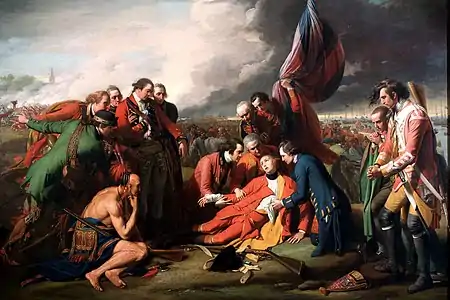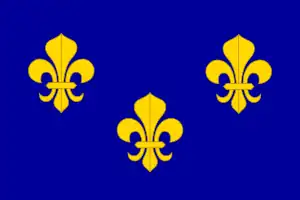| |||||
| Decades: |
| ||||
|---|---|---|---|---|---|
| See also: | |||||
| Part of a series on the |
| History of Canada |
|---|
 |
| Timeline (list) |
| Historically significant |
| Topics |
| By provinces and territories |
| Cities |
| Research |
Events from the year 1750 in Canada.
Incumbents
Governors
Events
- 1750s: Hudson's Bay Company Saskatchewan River region, reached by trade drummers sent out with goods to tempt the Indians to York.
- c. 1750: The Ojibwa begin to emerge as a distinct tribal amalgamation of smaller independent bands.
- German immigrants begin to arrive in numbers at Halifax.
- Hidatsa villages, site of ancient trading fair, now with both French and Hudson's Bay representatives present each summer.
Births
- James Glenie, army officer, military engineer, businessman, office holder, and politician (d.1817)
- Simon McTavish, fur trader and dealer in furs, militia officer, office holder, landowner, seigneur, and businessman (d.1804)
Deaths
- October 14: Richard Philipps, military officer, governor of Nova Scotia (b.1661)
Historical documents
- British ambassador complains to French about forts built on Isthmus of Chignecto by de la Jonquière (hostilities ensue)[3]
- Map: Fort Beauséjour on Isthmus of Chignecto[4]
- Edward Cornwallis reports that French intend to secure Chignecto with fortification and oath of allegiance (Note: "savages" used)[5]
- Cornwallis reports that Canadians threaten Acadians "with a general massacre[...]if they remain in the province" (Note: "savages" used)[6]
- Cornwallis advises Minas Basin Acadians they are deceived by Canadians "to lead you to your ruin" (Note: "savages" used)[7]
- British captain reports on naval engagement with French ships carrying arms and provisions to Indigenous people along Bay of Fundy[8]
- British ambassador says French unjustifiably occupy land from Chignecto to Saint John River before bilateral commission settles boundary[9]
- Letter from Father Le Loutre about movement of families to western Acadia and impatient wait for boundary decision (Note: "savages" used)[10]
- French answer British allegations by saying they seek good relations but intend to defend their land against British aggression[11]
- Though at same latitude, Nova Scotia not "so agreeable" as southern France because of cold and fog, which forest-clearing would remedy[12]
- Many in Halifax died of cold in winter of 1750 for lack of houses, and snow lying about tents "was enough to move the Heart of Stone"[13]
- Pehr Kalm's visit to Niagara Falls facilitated by French at Fort Niagara after he shows with passports that he is not a British officer[14]
- Reports say Detroit has hundreds living on 30-40 farms "in a fine champaign country," and villages of Wendat, Potawatomi and Odawa[15]
- To find Northwest Passage, sail east from Asia to "where it is probable the Weather is milder, and the Seas clearer of Ice"[16]
References
- ↑ Guéganic (2008), p. 13.
- ↑ "George I". Official web site of the British monarchy. 30 December 2015. Retrieved 18 April 2016.
- ↑ "It is proper to observe" An Impartial History of the Late War; Second Edition (1763), pgs. 16-20. Accessed 1 December 2021
- ↑ "Plan of the western part of the Chignecto Isthmus showing Beauséjour Fort and the surrounding area" (ca. 1750), McCord Museum. (See also "Plan of the Chignecto Isthmus showing Forts Beauséjour and Gaspareau") Accessed 6 December 2021
- ↑ "Govr. Cornwallis to Duke of Bedford" (excerpt; March 19, 1750), Nova Scotia Documents; Acadian French, pgs. 181-4. Accessed 6 December 2021
- ↑ Note to Earl of Albemarle, British ambassador to France (excerpt; June 4, 1750), British Diplomatic Instructions; 1689-1789; Volume VII, France, Part IV, 1745-1789, pgs. 9-10. Accessed 30 November 2021 (See Cornwallis letter with account of incidents including this threat)
- ↑ Letter of Edward Cornwallis (translation; approved of by Council, April 19, 1750), Nova Scotia Documents; Acadian French, pgs. 185-7. (See Cornwallis letter of reconciliation but firmness toward Acadians) Accessed 6 December 2021
- ↑ "An Extract of a Letter from Capt. Rous" (October 31, 1750), A Memorial Containg a summary View of Facts, with Their Authorities[...]; Translated from the French (1757), pgs. 45-7. Accessed 2 December 2021
- ↑ "Memorial concerning Nova Scotia" (July 7, 1750), in John Entick et al., The General History of the Late War; Vol. I (1763), pgs. 30-3. (See pro-French author's critical comments on ambassador's remarks; also see British boundary commissioners' opening memorial (September 21, 1750)) Accessed 1 December 2021
- ↑ "From M. Loutre to M. Bigot, Commissary of New France" (translation; August 15, 1750), Nova Scotia Documents; Acadian French, pgs. 193-4. (See "Extract from a Document" attributed to French officer who accuses Le Loutre of murdering British officer) Accessed 7 December 2021
- ↑ "A Memorial in Answer to the Complaints made by England" (September 15, 1750), A Memorial Containing a summary View of Facts, with Their Authorities[...]; Translated from the French (1757), pgs. 53-6. Accessed 3 December 2021
- ↑ "As to the Climate" A Genuine Account of Nova Scotia (1750), pg. 4. Accessed 1 December 2021
- ↑ John Wilson, "Many unfortunate People" A Genuine Narrative of the Transactions in Nova Scotia, Since the Settlement, June 1749[....], pg. 10. Accessed 1 December 2021
- ↑ "To Benjamin Franklin from Peter Kalm, 2 September 1750" U.S. National Archives. Accessed 8 December 2021
- ↑ "But at le Detroit" The Contest in America between Great Britain and France (1757), pgs. 175-6. Accessed 3 December 2021
- ↑ Henry Ellis, Considerations on the Great Advantages which would arise from the Discovery of the North West Passage (1750), pg. 5. Accessed 6 December 2021
This article is issued from Wikipedia. The text is licensed under Creative Commons - Attribution - Sharealike. Additional terms may apply for the media files.
.svg.png.webp)
